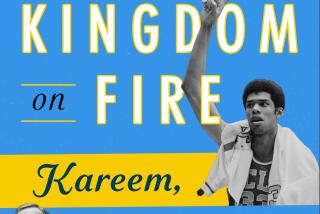Follow the ball through ‘Wooden: A Coach’s Life’ biography
In July 2009, a year before his death at age 99, John Wooden was named by the Sporting News as the top coach in the history of American sports. Not many argued with the selection. Over his 29-year career he won 664 of 826 games for a winning percentage of .804. From 1964 through 1975 his UCLA Bruins won 10 NCAA championships, and UCLA’s games drew higher TV ratings than most NBA games.
Surprising as it seems, Wooden, arguably the most influential coach in basketball history, has never had a definitive biography until now. In “Wooden: A Coach’s Life,” Seth Davis, a senior writer at Sports Illustrated and studio analyst for CBS Sports, has written a virtual cutaway view of the history and evolution of basketball in the form of a biography. Davis takes us on bus rides over snow-covered roads to Friday-night high school games, puts us in the frantic and precarious whirl of semi-pro basketball barnstorming in the Midwest and, finally, gives us a courtside seat in the high-stakes pressure cooker of big-time college basketball.
John Robert Wooden was born in 1910 in Martinsville, Ind., which “unlike neighboring Ohio ... did not have a bunch of urban manufacturing centers with schools big enough to field football teams.” Wooden’s first love was baseball, but he found himself swept up in Indiana’s passion for “basket ball,” as it was called.
He practiced with a ball made of old socks stitched together by his mother, shooting at a tomato basket hung from a hayloft. John drew his inspiration from basketball’s inventor, Dr. James Naismith, an enthusiastic proponent of “muscular Christianity.” Naismith, in turn, influenced Indiana’s coaches, including Ward “Piggy” Lambert, who coached Wooden at Purdue.
After a college playing career that would earn him a plaque in the Basketball Hall of Fame — he was the first man to be inducted as both a player and coach — Wooden pursued a master’s degree while teaching high school English and coaching basketball. He also made extra bucks barnstorming with his basketball pals in small towns. In these years Wooden’s famous Pyramid of Success, emphasizing the building blocks of sacrifice, dedication and hard work, began to take shape. It would remain part of his curriculum at the high school and college levels and even into his retirement.
In 1948, a blizzard in Minnesota prevented a job offer from the University of Minnesota from getting to Wooden. He and his wife, Nell, decided to take their second choice, the head coaching job at UCLA. In 1947 the Bruins had finished 12-13; in Wooden’s first season they soared to 22-7, the best record in school history.
California was something of a disappointment compared to Indiana, where, as Davis writes, “Basketball was religion. Here it was a diversion.” But by the end of the 1960s, UCLA had become the center of the college basketball world, with Frank Sinatra and Bob Hope often seated in attendance at Pauley Pavilion. Wooden’s greatest players, such as Lew Alcindor (later Kareem Abdul-Jabbar) and Bill Walton, became household names.
Wooden always insisted that he was not motivated by money. For his first four years, to make ends meet he worked mornings in the San Fernando Valley as a dispatcher for a dairy company. Even after winning championships he supplemented his income coaching youth basketball camps. For years his salary at UCLA was around $6,000, and even at the peak of his success he didn’t top $35,000.
“A Coach’s Life” is all the more compelling because it isn’t a hagiography. The coach saw himself as an idealist; Davis knows better. “Wooden could talk all he wanted to his players about his definition of success, about how their only worry should be whether they were maximizing their potential … [but] his players saw the deeper truth. This was one mean English teacher, and he wanted to win very badly.”
Some of Wooden’s players, particularly Walton, idolized him; others, such as Lucius Allen, did not. In a post-career interview, Wooden said that he wanted his players “to know that I was very interested in them as a person, not just as a basketball player.” Allen disagreed, remarking that his former coach “deluded himself into thinking he was that way. … When we were there I did not like that man very much.” An anonymous player talking to Sport magazine spoke for many players: “He’s a genius of a coach, but we all wonder how he got the kindly grandfather image.”
Still, no one ever doubted Wooden’s ability to motivate. In his later years he achieved the status of life coach he had always wanted. Into his late 90s he continued giving speeches and lectures, mailing thousands of copies of his Pyramid of Success to fans.
Davis sums up his account of an epic life in his superb biography: “To many of Wooden’s players, he didn’t even start making sense till long after they had left his classroom.” Even Allen, after achieving stardom in the NBA, conceded that “It took me three years to realize what a gift I got from that man. I was using the Pyramid of Success and not even realizing it.”
Barra’s latest book is “Mickey and Willie: The Parallel Lives of Baseball’s Golden Age.”
Wooden
A Coach’s Life
Seth Davis
Times Books: 608 pp, $35.00
More to Read
Sign up for our Book Club newsletter
Get the latest news, events and more from the Los Angeles Times Book Club, and help us get L.A. reading and talking.
You may occasionally receive promotional content from the Los Angeles Times.






